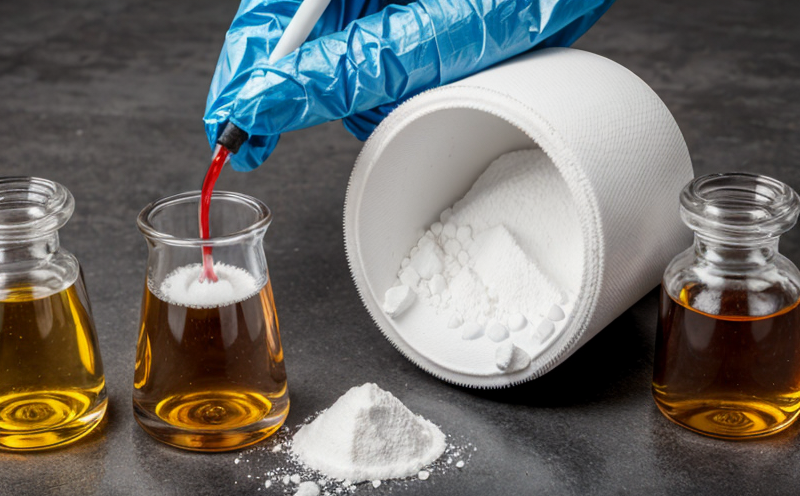UL 1672 Adhesive and Sealant Chemical Safety Testing
The UL 1672 standard is a critical component of ensuring the safety, quality, and compliance of adhesives and sealants used in various industries. This standard addresses the chemical composition and potential hazards associated with these materials, which are integral to many applications from construction to electronics.
Electronics manufacturers often rely on adhesives and sealants for their robustness, durability, and resistance to environmental factors such as temperature fluctuations and moisture exposure. However, due to the diverse chemical compounds used in these products, ensuring that they do not pose a risk of toxicity or other hazards is paramount.
UL 1672 testing focuses on identifying potential health risks from volatile organic compounds (VOCs), heavy metals, and other chemicals present in adhesives and sealants. The test protocol ensures that these materials meet stringent safety standards set forth by the Underwriters Laboratories (UL).
The testing process typically involves several steps, including sample preparation, chemical analysis, and compliance evaluation. Samples are prepared according to specific guidelines outlined in UL 1672, which may vary based on the type of adhesive or sealant being tested.
Once samples are ready for analysis, they undergo a series of tests designed to evaluate their chemical composition. These tests can include gas chromatography-mass spectrometry (GC-MS), inductively coupled plasma mass spectrometry (ICP-MS), and other advanced analytical techniques that provide detailed information about the components present.
The results from these analyses are then compared against established limits specified by UL 1672. Compliance with these limits ensures that adhesives and sealants meet safety standards, protecting users from potential health risks while maintaining product integrity.
By adhering to UL 1672 guidelines, manufacturers can demonstrate their commitment to producing safe and reliable products. This is particularly important for companies operating in sectors where the quality of materials used directly impacts user safety.
| Standard | Description |
|---|---|
| UL 1672 | This standard sets forth requirements for the chemical safety of adhesives and sealants, ensuring they meet specified limits regarding harmful substances. |
| ASTM D4285 | Method for evaluating the volatile organic compounds (VOCs) emitted by materials used in electronics manufacturing. |
Why It Matters
The importance of UL 1672 testing cannot be overstated, especially for manufacturers involved in the electronics industry. Adhesives and sealants play a crucial role in ensuring the longevity and performance of electronic devices across various environments.
One key reason this testing is essential lies in its ability to identify potential health hazards associated with certain chemicals commonly found in these materials. For instance, some adhesives may contain volatile organic compounds (VOCs) that can off-gas over time, leading to indoor air quality issues if not properly managed.
Another critical aspect is the protection of end-users. Many electronic products are used in both residential and commercial settings where prolonged exposure to harmful chemicals could pose serious health risks. By adhering to UL 1672 standards, manufacturers ensure that their products contribute positively to indoor air quality and overall user well-being.
From an operational perspective, compliance with these regulations helps companies avoid costly recalls and negative publicity associated with unsafe products. It also enhances brand reputation by demonstrating a commitment to high-quality manufacturing practices.
In summary, UL 1672 testing is crucial for maintaining safety standards in electronics manufacturing while fostering trust between manufacturers and consumers alike.
Applied Standards
- UL 1672 - Chemical Safety of Adhesives and Sealants
- ASTM D4285 - Volatile Organic Compounds Emission Testing
Environmental and Sustainability Contributions
The implementation of UL 1672 testing contributes positively to environmental sustainability by promoting the use of safer adhesives and sealants in electronics manufacturing. By ensuring that these materials do not contain harmful chemicals, manufacturers can reduce their environmental footprint.
One significant contribution is reducing VOC emissions, which are known contributors to poor indoor air quality. Through rigorous testing procedures like those specified in ASTM D4285, companies can minimize the release of harmful vapors into the atmosphere.
Beyond just emission control, UL 1672 also promotes responsible resource management by encouraging the use of environmentally friendly materials. This approach supports broader sustainability goals such as waste reduction and energy efficiency in production processes.
For electronics manufacturers, adopting sustainable practices can lead to long-term cost savings through reduced regulatory compliance costs and improved reputation among eco-conscious consumers. Ultimately, adherence to these standards helps create a more responsible and resilient supply chain for the industry.





